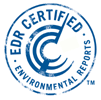What is radon?
Radon is a radioactive gas produced by the natural breakdown of uranium (which is present in soil and in rock formations throughout the United States). Studies have shown that exposure to radon contributes to the incidence of lung cancer. The EPA advises you to take action to reduce the level of radon in your air if it exceeds 4.0 pci/L (picocuries per liter) in the lowest "livable" level of your home.
Am I required to have a radon test?
Generally, you are not required to perform a radon test to qualify for a mortgage, but you may want to have the test done so that you will know the results before you proceed with the purchase of the property.
How does Total Home Inspection test for radon levels in the air?
We place EPA approved devices, either two e-perm canisters or one continuous "Sun Nuclear Monitor", in the lowest livable area of the home. If the basement is a space that could be used as a workshop, playroom or exercise room, or could be a finished space in the future, then that is the space you should test (because it is the entry level of radon). It should be noted that another way for radon to enter the home is by escaping from well water supply (sinks, washing machines, shower, etc). If your water supply is from a private well, we recommend that you also test for radon in the water supply).
The test devices remain in the home for at least 48 hours. The laboratories we use to decipher the e-perm canisters are EPA/RMP certified. You will receive your test results in one to two business days after the test device(s) are picked up, by e mail or fax. The "hard copy" will be mailed to you the same day.
What are the required guidelines that must be followed?
The EPA Guidelines in Real Estate Pre-Purchase transactions are as follows:
- All windows and doors must be kept closed 12 hours before the start of the test and during the 48 hour test, except as required for normal entry and exits.
- Place detectors off the floor at least 20", on a table or chair, 1' from any outside walls, 3' from doors or windows.
- Do not place in or on fireplaces.
- Do not place in hot areas near furnace or stove, in direct sunlight, in drafts, or near sources of moisture.
- Do not disturb for 46-72 hours.
- Properly cap and immediately mail the devices to an approved laboratory.
Yes, radon levels in the house can vary depending on a number of conditions that include (but are not limited to) barometric pressure changes, unstable weather conditions, rain, snow accumulations, etc. That is why the EPA recommends that homeowners test their homes several times during the year to determine the average annual level. However, if the homeowner has not done that, you as the buyer would have to obtain short-term results by performing a short-term test along with your home inspection.
According to the EPA in its pamphlet "Has your home been invaded by Radon?":
"Short and long-term results should be interpreted differently. If your long-term results are high, you should definitely take action to fix your home, as soon as possible. " "If your short-term results are high, the best way to determine your annual level is by doing a long-term test of one year. Preliminary research shows that short-term results from tests made during the cooler months generally overestimate annual level by one to three times. For example, if your short-term test result is 6 pCi/L then your annual average level is probably between 2 pCi/L and 6 pCi/L. If your short-term test results are low, you may want to test again at some time in the future. This is to make sure that your test was not conducted at a time when radon levels happened to be much lower than usual."
Unfortunately, in a pre-purchase situation the buyer has a small window of opportunity to obtain accurate information about the radon level in the home you are considering. Therefore, your only option is a short-term test.
How will I know if the homeowners followed the guidelines?
If you have concerns about the sellers following the protocol, we encourage buyers to put their concerns in writing to the realtor(s) and homeowner(s). You should state that: You are concerned about the validity of the radon air test. You want assurances that EPA guidelines will be followed, i.e. - doors and windows to the exterior closed for twelve hours prior to the test, and during the 48 hours of the test, except for normal entering and exiting. You should state that you will retest upon moving into the property. Also, you could include the following information in your statement: *According to the EPA, radon is a health hazard, and it poses a considerable health risk. *According to the EPA, it is the second leading cause of lung cancer in our country. *Some of the New England States are known to have areas that show high concentrations of radon.
Are there any scientific studies on this subject?
- Epidemiology Journal - Radon Study
- CA Cancer Journal - Radon Report
Adobe Acrobat (PDF) documents can be viewed and printed from any Web browser with Adobe Reader. If the above document does not open automatically, you can download and install Adobe Reader for FREE at the Adobe Download Page.
World Health Organization Takes Action Against Lung Cancer With New 2.7 Radon Limit
Sep 28, 2009 (PRN): The World Health Organization announced that they have established a new limit for indoor radon gas. The new maximum radon level is 2.7. This is a 32% reduction from the previously accepted "action level" of 4.0.
This new limit was prompted by a recent compilation of studies submitted by scientists throughout the World which conclusively point to radon as the second leading cause of lung cancer next to smoking. Based on the new 2.7 threshold, millions of homes will require repairs to reduce the levels of the gas.
Each year, hundreds of thousands of deaths throughout the World are caused by exposure radon (more than any other hazard in the home including fires, carbon monoxide, falls, drowning, poisonings, handguns, etc.) This new plan of action by the World Health Organization will save millions of lives.
More than 100 scientists from 30 countries participated in the World Health Organization International Radon Project and assisted in the publishing of the Handbook on Indoor Radon which was released earlier this month. The book is a useful resource for concerned homeowners or anyone who wants to learn more about the toxic carcinogen known as radon. It outlines the years of research and the very conclusive findings that have triggered a push for stricter legislation and construction practices that will reduce the risk of lung cancer from indoor radon exposure.
You can download a copy of the International Radon Handbook.
According to Jamey Gelina, a radon remediation specialist with Air Quality Control Agency; "All homes should be tested for radon regardless of the geographic location or type of construction. Since radon gas cannot be detected by human senses, the only way to know if a home has a radon problem is to conduct the test."Air Quality Control has fixed radon problems in over 20,000 homes throughout North America. "We have worked with countless families who have been victims of radon induced lung cancer which could have been prevented with improved awareness of this very common problem." Mr. Gelina added.
We recommend that you visit the following web sites, to become more familiar with radon:
- World Health Organization Handbook
- Connecticut State Department of Health
- National Radon Safety Board
- E. P. A.
- National Safety Council - Radon Fact Sheet
- Radon Testing Corporation of America
- University of Iowa
- Dr. P. Price & Prof. A. Gelman Study
- Granite and Radon
- Marble Institute of America - Granite and Radon Info
- Marble Institute of America - Response to NYT Article
- Other Radon Links


